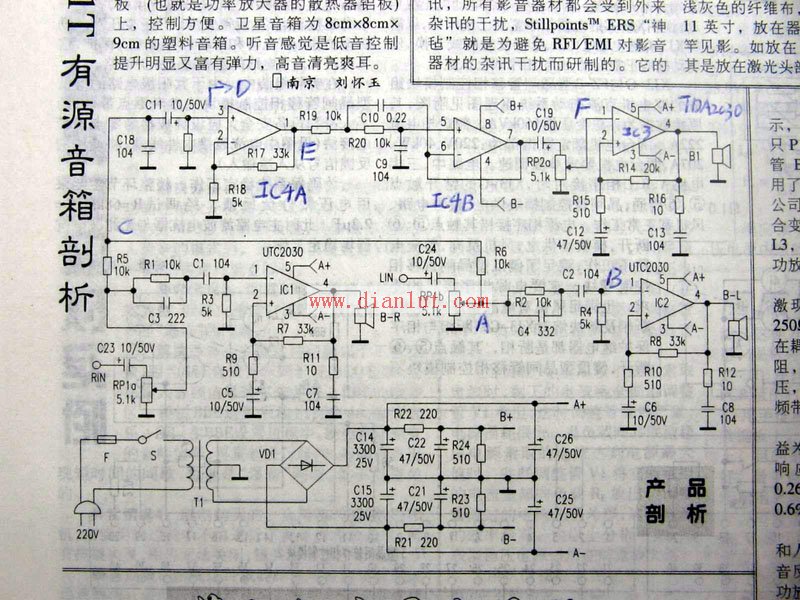 The following is the circuit diagram of [JRC4558 working principle and circuit].
The following is the circuit diagram of [JRC4558 working principle and circuit].

The working principle, as shown in the picture, is mainly divided into three parts: the power circuit, the satellite box power amplifier circuit, and the subwoofer circuit.
First, the power circuit (located at the bottom of the diagram): 220V AC from the mains passes through a fuse (F) and a switch (S), then enters the primary winding of a transformer. The secondary side of the transformer outputs two 12V AC signals. These are rectified by a bridge rectifier made up of VD1, and filtered by capacitors C14 and C15 (each 3300µF/25V). The no-load output voltage is approximately ±16V (which is about 1.414 times 12V). This provides power for the three TDA2030 and UTC2030 amplifier chips. A separate step-down is done using resistors R21 and R22 to supply ±12V to the bass preamplifier and low-pass filter IC4 via B+ and B-.
It’s worth noting that this design doesn’t use a standard 78/7912 voltage regulator for the preamplifier power supply. If you're building or modifying the circuit, replacing the two 3300µF capacitors with higher-quality ones could help improve stability. You might also consider adding an LM7812 or LM7912 to ensure a more stable power supply for the front-end section.
Second, the left and right channel amplification circuit (satellite box power amplifier). Since both channels are identical, I’ll focus on the left channel as an example. As shown in the diagram, RIN is the signal input terminal, which connects to a volume potentiometer via coupling capacitor C23. The volume control adjusts the signal level before it goes into a treble boost circuit made of R1 and C3. This helps enhance high-frequency response, making the sound clearer.
After that, the signal is sent to the left channel power amplifier via coupling capacitor C1, which connects to pin 1 of the UTC2030 chip. After amplification, the signal is output from pin 4 of the UTC2030 to drive the satellite speaker. R7 and R9 form the feedback network, determining the gain of the amplifier. By adjusting R7, you can change the amplification factor. R11 and C7 make up the speaker compensation network, helping to stabilize the output and prevent distortion.
Third, the subwoofer circuit. The signal from the left and right channels passes through two 10kΩ resistors (R5 and R6) and then into a coupling capacitor C11. It then enters IC4, which is a JRC4558 operational amplifier. Pin 3 of IC4A serves as the subwoofer preamplifier stage. R201T sets the gain to around 6 times, ensuring sufficient signal strength for the subwoofer.
The output of IC4A (pin 15) goes through resistor R19 and into a low-pass filter composed of IC4B, C9, C10, and R20. This filter cuts off frequencies below 200Hz, allowing only the low-frequency signals to pass through. The cutoff frequency is determined by R20 and C10. After filtering, the signal is connected to the volume control potentiometer. Once adjusted, the signal is sent to the subwoofer power amplifier, which uses the TDA2030A. Its operation is similar to the satellite box amplifier, with the output from pin 4 driving the woofer.
One thing to note: there's an error in the original diagram. The input pin (pin 1) of the TDA2030A should be marked as “+†(non-inverting input), but in the drawing, pins 1 and 2 are reversed.
Additionally, it’s important to mention that other chips like the LM1875T used in models such as Edifier R1900TII, Light Cavalry V23SE, and Swans M200 series have a similar working principle to the TDA2030A described here.
(Editor: Circuit Diagram)
Octagonal telephone pole is a telephone pole with eight sides, giving it a unique octagonal shape. These steel poles are often used to support power lines, street lights, and other electrical infrastructure. The octagon provides additional strength and stability compared to traditional round poles, making it ideal for areas with strong winds or other environmental challenges. Depending on the specific requirements of the installation, they are usually made of materials such as wood, steel or concrete.
Octagonal Pole,Hotconical Electric Pole,Electric Mast Pole,Composite Utility Pole
JIANGSU HONGGUANG STEEL POLE CO., LTD. , https://www.hgsteelpoles.com